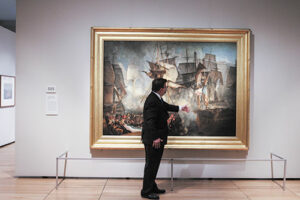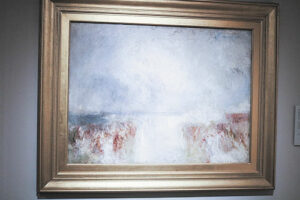Kimbell Art Museum Deputy Director George Shackleford points out the Whalers paintings.
(David Taffet/Dallas Voice)
The Kimbell Art Museum features 100 works by the British painter J.M.W. Turner
DAVID TAFFET | Senior Staff Writer
taffet@dallasvoice.com
J.M.W. Turner was more influential than any other British artist and WAS the most influential artist of his era working anywhere, according to the Kimbell Art Museum’s Deputy Director George Shackelford, who curated the exhibit Turner’s Modern World currently at the Kimbell.
Turner’s early works would have established him as one of Britain’s great painters. His later political work and then his final, more abstract works place him tops among British painters. Turner, who lived from 1775 to 1851, laid some of the foundations for what became modern art.
The exhibit at the Kimbell includes more than 100 works, a massive number of oil canvasses, watercolors and sketches by the prolific artist. The lead organizer of the exhibit, London’s Tate, was the recipient of Turner’s bequest upon his death of 300 oil paintings and 35,000 works on paper. In addition to pieces from the Tate, Yale’s British collection, the Cleveland Museum of Art, the Met in New York and more contributed some of the show’s key works.
Turner addressed social issues of the day — voting rights, abolition of slavery, freedom of expression and religious tolerance — and he grew more liberal in his views as he developed as an artist. While earlier works glorified war, later works showed compassion for the suffering that resulted from war.

George Shackelford explains the nuances of Turner’s The Battle of Trafalgar. (David Taffet/Dallas Voice)
In 1897, Napoleon conquered Italy and then invaded Egypt. England feared it would suffer the same fate. But in the Battle of Trafalgar, Lord Nelson rammed the French and Spanish fleet that had gathered near the southern tip of Spain, thus averting an invasion of the British Isle.
From 1806 to 1808, Turner painted The Battle of Trafalgar, as Seen from the Mizen Starboard Shrouds of the Victory, among the most dramatic canvasses in the show. Here, Turner glorifies the battle during a period when England was at war in Europe and in North America.
But in The Field at Waterloo, painted about 10 years later, fields of dead include women and children. Their faces reveal the agony of war.
Shackelford describes Turner as a great self-promoter. One painting produced early in Turner’s career was one he created in hopes of selling it to the future King George IV. Because the canvas was among those left to the Tate, Shackelford said, we know his attempt to sell it to the regent was unsuccessful.
Other paintings from his early career, however, include several of newly-dug English canals. The owner of the company digging some of those new waterways was a patron of Turner’s, and the artist produced beautiful canvases to glorify the modern transportation marvel.
Turner was among the first to incorporate new technology like the steam engine into his work. Steamships and steam locomotives changed transportation during the industrial revolution. Shackleford said those machines were revolutionary because they changed how people thought of distance, speed and time. A trip that used to take several days was reduced to less than a day.
Turner didn’t just observe the new steam-powered forms of transportation; he rode them, too. Steam engines became the symbol of modern society, and as he incorporated new technology into his paintings, Turner began using a more modern style.
To depict a fire at Parliament that he watched, possibly from a steamship in the Thames, Turner developed new methods of applying paint to canvas. He used a knife to apply the thick smoke and small brush strokes to render small flickering flames.

The Disembarkation of Louis-Philippe at the Royal Clarence Yard, Gosport, 8 October 1844
His painting of whalers at sea are more impressionistic, though Turner is never referred to as an Impressionist, a movement that began after his death. But stand back from the whalers, and the scene comes into focus. Come too close, and the brush strokes almost overpower the scene.
Shackelford said promoter Turner sold a number of his whaling canvasses. But his attempts at new ways to depict a scene on canvas were not universally accepted at the time, and some of those works were returned by the more traditional art patrons for not being quite finished.
As the 1800s progressed, England’s political system became more progressive, with voting rights extended to more people. Turner painted political canvasses whose themes would have been evident at the time. One plays off the news that the king was promoting turnips for human consumption. Until that time, turnips were considered just food for cattle. Poor farmers are in the foreground of Turner’s paintings on turnips, with their cows eying the vegetable for themselves. Windsor Castle stands in the background.
Another painting depicts the sinking, off the coast of France, of a ship carrying a “cargo” of women prisoners and their children to the prison colony of Australia. Lives could have been saved when the ship sank, but the captain was afraid the prisoners would escape. So, all but three crew members died. Turner’s work captures the look of terror on the captives faces before the ship sinks.
A number of paintings in this exhibit are ones Turner considered unfinished, and they were never exhibited in his lifetime. In some cases, only the name of the paintings give away their unfinished status though, because the works stand on their own as is.
One of those is titled The Disembarkation of Louis-Philippe at the Royal Clarence Yard, Gosport, 8 October 1844. It’s a beautiful painting, but no one is disembarking anything. There is no ship in sight.
Shackelford said that any modern painter was either inspired by works of Turner’s they had seen themselves, or they were inspired by artists who were influenced by Turner. His brush strokes, his use of color, his composition, his incorporation of the latest technology at the time — all of that combines into canvasses of modern subjects, making Turner the first modern master.
Turner’s Modern World runs Oct. 17-Feb. 6 at the Kimbell Art Museum, 3333 Camp Bowie Blvd., Fort Worth. $18. KimbellArt.org.












